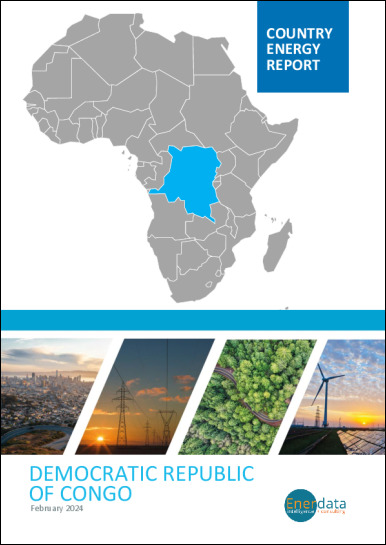- Update
-
- Format
- 3 files (PDF report, 2 Excel files)
- Pages
-
27 (Report only)
- Delivery
- Immediate by e-mail
- GENERAL OVERVIEW
- INSTITUTIONS AND ENERGY POLICY
- ENERGY COMPANIES
- ENERGY SUPPLY
- ENERGY PRICES
- ENERGY CONSUMPTION
- ISSUES AND PROSPECTS
- DATA TABLES
- ABBREVIATIONS
- GLOSSARY
Buy Congo DR energy report
Price without VAT. Depending on your statute and location, VAT might be applicable. Get in touch with us for more information.
After validation, you will immediately receive 3 files by email (one pdf report and 2 excel files containing the datasets).
Overview
This analysis includes a comprehensive Congo DR energy market report and updated datasets. It is derived from the most recent key economic indicators, supply and demand factors, oil and gas pricing trends and major energy issues and developments surrounding the energy industry. The report provides a complete picture of the country situation, dynamics, current issues and future prospects. With market data and continuous follow-up of markets news, this report brings clear and concise insights with which to tackle national energy challenges and opportunities. Browse the tabs below for a detailed table of contents, the list of graphs and tables, and details on the data files.
Highlights
- The Government aims to increase the electrification rate to 100% in 2045 and to exploit the huge hydro potential.
- Perenco is the only oil producer.
- Electricity is produced almost entirely from hydro.
- The oil production is entirely exported.
- Motor fuel prices are among the highest in Sub-Saharan Africa.
- More than 90% of energy needs are covered by biomass.
- The electrification rate is among the lowest in the world (22%).
- Several hydropower projects are under development, including the Grand Inga plant, which would be the largest hydropower plant in the world.
- Around 2 GW of solar power plants are planned.
Institutions & Energy Policy
The Ministry of Energy and Hydraulic Resources controls the power sector.
The Ministry of Hydrocarbons is in charge of oil and gas issues. The Ministry of Environment and Sustainable Development is responsible for the management of forests and climate change.
Energy Companies
Oil:
Perenco is the only company involved in oil production. It had a production of 20 kb/d in 2023, mainly offshore in the Costal Basin. It operates 14 onshore and offshore fields in the country. The whole production is transported to the Kalamu floating terminal, with a storage capacity of 1 mbl.
Energy Supply
Oil:
Oil production remained stable in 2023 (1 Mt). It was roughly stable between 2008 and 2021 (1.1-1.2 Mt) and decreased slightly in 2022. It declined between a peak of 1.4 Mt in 2004 and 2008.
Since the closure of the SOCIR refinery in 2001, all the crude oil production is exported.
Energy Prices
Oil:
Gasoline and diesel prices are very high (among the top five countries in Sub-Saharan Africa). They decreased slightly in 2023 to US$1.39/l after a drastic increase of 50% in 2022 to about US$1.5/l, following global price trends.
Energy Consumption
Energy consumption per capita is 0.38 toe, including around 128 kWh of electricity (2023).
Total consumption has increased by 4%/year since 2020.
Biomass covers 92% of the country's energy needs. Although it has a large surplus of firewood, the eastern part of the country, which is more populated, is subject to fast deforestation, just like the periphery of the cities.
Issues & Prospects
Electricity:
About 50 GW of new capacities are announced. The most important project is Grand Inga (more than 40 GW of potential), which would be the world's largest hydroelectric dam (almost two times bigger than the three Gorges facility in China).
- GRAPH 1: CO2-energy emissions (MtCO2)
- GRAPH 2: Installed electric capacity by source (2023, %)
- GRAPH 3: Gross power production by source (TWh)
- GRAPH 4: Power generation by source (2023, %)
- GRAPH 5: Gasoline & diesel prices (US$/l)
- GRAPH 6: Consumption trends by energy source (Mtoe)
- GRAPH 7: Total consumption market share by energy (2023, %)
- GRAPH 8: Final consumption market share by sector (2023, %)
- Economic Indicators: Annual historical data including population, GDP growth, imports and exports, inflation rate, energy security and efficiency indicators, CO2 emissions.
- Supply Indicators: Historical data including oil and gas reserves, electric and refining capacity, energy production, power production and external trade. All are detailed by energy source.
- Demand Indicators: Historical data including consumption per inhabitant, consumption trends, total consumption by energy source, final consumption by energy source and sector, and electricity consumption by sector.
- Energy Balances: Single table displaying the overall energy industry balance per annum, also graphically displayed by energy sub-segment.
- Infrastructure Projects: Covers power plant projects by energy, technology, status and operator.
The Congo DR energy market data since 1990 and up to
is included in the Excel file accompanying the Congo DR country report.
It showcases the historical evolution, allowing users to easily work with the data.
Key Data included in the excelsheet:
- Economic indicators: Annual historical economic indicators, energy security, energy efficiency and CO2 emissions.
- Supply indicators: Annual historical reserves, capacity, production and external trade (imports(+) exports(-) balance).
- Demand indicators: Annual historical consumption per capita, consumption trends, total consumption, final consumption (per energy and per sector) and electricity consumption total and per sector.
- Energy Balance: total and per energy.
- Congo DR Energy Prices: In addition to the analysis provided on the report we also provided a data set which includes historical details on the Congo DR energy prices for the follow items: price of premium gasoline (taxes incl.), price of diesel (taxes incl.), price of electricity in industry (taxes incl.), price of electricity for households (taxes incl.), price of natural gas in industry (taxes incl.), prices of natural gas for households (taxes incl.), spot price of Brent and CO2 emissions (from fuel combustion).
 Energy and Climate Databases
Energy and Climate Databases Market Analysis
Market Analysis